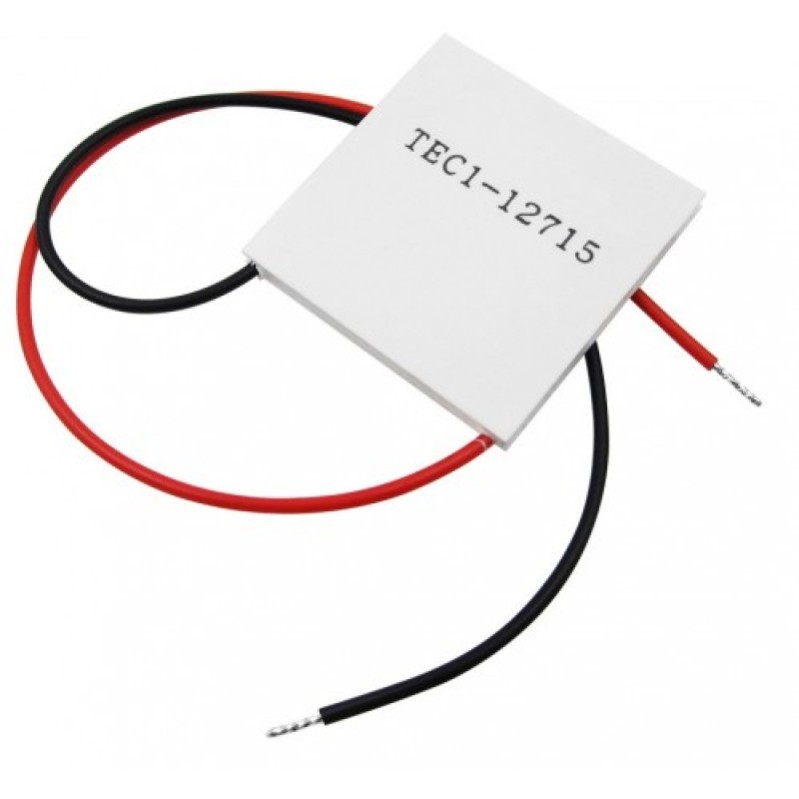








TEC1-12706 Thermoelectric Peltier Cooler Module
Peltier module (thermoelectric module) is a thermal control module that has both "warming" and "cooling" effects. By passing an electric current through the module, it is possible to change the surface temperature and keep it at the target temperature.
₹ 195 ₹399
399



| Made In : | India |
Add FAQ
A Peltier module (also known as a thermoelectric cooler or TEC) is a device that uses the Peltier effect to create a temperature difference between its two sides. It can either cool or heat depending on the direction of current flow. Peltier modules are widely used in applications requiring temperature control, such as in electronics cooling, small refrigeration systems, and temperature regulation in various devices.
Key Features:
-
Operation Principle:
- Peltier Effect: When current flows through the module, heat is absorbed from one side (cold side) and released to the other side (hot side). This temperature difference is created by the movement of heat through the module’s semiconductor materials.
- Reversible Operation: By reversing the polarity of the applied voltage, the hot and cold sides of the module can be swapped, allowing the device to act as either a cooler or a heater.
-
Construction:
- Semiconductor Materials: Peltier modules are typically made of bismuth telluride (Bi2Te3) or similar semiconductor materials arranged in a series of thermocouples.
- Ceramic Plates: The semiconductor materials are sandwiched between two ceramic plates, which help in transferring heat and providing structural support.
- Terminals: Electrical connections at the ends of the module allow it to be connected to a power source.
-
Thermal and Electrical Characteristics:
- Cooling Capacity: Depends on the size of the module, the temperature difference, and the electrical current applied. Cooling capacities can range from a few watts to several hundred watts.
- Power Consumption: Requires a DC power supply. The power consumption varies based on the module’s size and cooling capacity.
- Temperature Difference: The maximum temperature difference between the hot and cold sides depends on the module's specifications and operating conditions.
Types of Peltier Modules:
-
Single-Stage Modules:
- Operation: Provides a single temperature gradient. Suitable for applications where a moderate temperature difference is required.
- Applications: Small cooling or heating tasks, such as cooling electronic components or small enclosures.
-
Multi-Stage Modules:
- Operation: Stacked modules to achieve a greater temperature difference. Provides higher cooling or heating capacities.
- Applications: Larger cooling systems, refrigeration units, or advanced temperature control systems.
Example of a Peltier Module (e.g., TEC1-12706):
Specifications:
- Voltage: Typically 12V DC.
- Current: 6A (max current rating).
- Cooling Capacity: Around 60W (varies with the temperature difference and operating conditions).
- Temperature Difference: Can achieve a temperature difference of up to 70°C to 80°C between the hot and cold sides.
Wiring and Usage:
-
Wiring Diagram:
- Power Supply: Connects to a DC power source. The positive terminal of the power supply goes to the positive terminal of the Peltier module, and the negative terminal goes to the negative terminal of the module.
- Heat Dissipation: Proper heat sinks or fans should be used to dissipate heat from the hot side of the module to maintain efficiency.
// Pin Definitions
const int peltierPin = 9; // MOSFET Gate to control the Peltier module
const int tempPin = A0; // LM35 temperature sensor analog pin
// Desired temperature threshold (in Celsius)
const int desiredTemp = 30; // Set the threshold temperature for cooling
// Variables
int temperature = 0; // Variable to store the temperature reading from LM35
int pwmValue = 0; // Variable to store PWM value to control the Peltier module
void setup() {
// Initialize serial communication for debugging
Serial.begin(9600);
// Set the Peltier control pin as output
pinMode(peltierPin, OUTPUT);
}
void loop() {
// Read the analog value from the LM35 temperature sensor
temperature = analogRead(tempPin);
// Convert the analog value to temperature in Celsius (LM35 gives 10mV per °C)
temperature = map(temperature, 0, 1023, 0, 500); // LM35 gives 500 = 50°C at full scale
// Display the temperature
Serial.print("Current Temperature: ");
Serial.print(temperature / 10.0); // Divide by 10 to get the actual temperature in Celsius
Serial.println(" °C");
// Compare the temperature to the desired threshold
if (temperature / 10.0 > desiredTemp) {
// If the temperature is higher than the threshold, cool down
pwmValue = 255; // Full power to the Peltier (cooling)
Serial.println("Cooling ON");
} else {
// If the temperature is below the threshold, turn off the Peltier
pwmValue = 0; // No power to the Peltier
Serial.println("Cooling OFF");
}
// Apply the PWM signal to the MOSFET to control the Peltier
analogWrite(peltierPin, pwmValue);
// Wait for a short period to avoid excessive serial prints
delay(1000);
}
0 Reviews For this Product













.jpg&width=225&quality=80)
